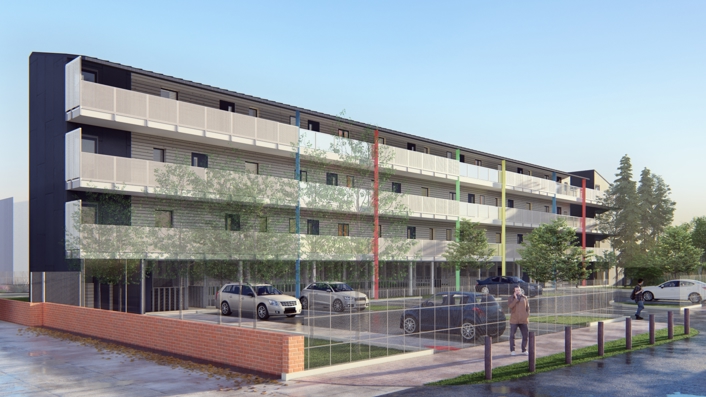Plans on short-stay accommodation for homeless people at Henwood Road car park approved
Published: 05/09/2022
Ambitious plans have been approved to create new high quality short-stay accommodation apartments for homeless people on the under-used Henwood car park on the edge of Ashford town centre.
This will be the first-of-its-kind modular development in the borough. It will be built on a steel podium, and all necessary safety features and flood risk mitigation measures have been adopted for this scheme due to the site situated in a flood zone area.
Ashford Borough Council has teamed up with ZED PODS, an award-winning British modular company, to design and build 23 high-quality, extremely energy efficient, factory-produced modular homes for the site.
These homes are highly-insulated and triple-glazed, with heat recovery ventilation and featuring 175 solar panels integrated into the roof. The fabric of the building is designed to create zero carbon homes with very low energy consumption and running costs.
One of the benefits of using modular construction is that the disruption on site to surrounding residents and businesses during construction will be less than a traditional build. The time it takes to complete the work will also be shortened. The 23 units of short-stay apartments will be a ‘stepping stone’ until individuals or households who have become homeless are able to move-on to more permanent accommodation.

Henwood car park operates at around 20% capacity and has been at this level for many years. It will be actively managed by Council staff to make sure the site is run efficiently, in a similar way that Christchurch House and Christchurch Lodge, the Council’s two other short-stay accommodations sites, are managed.
Sense of community
The 23 self-contained homes are a mix of 13 one-bed, nine two-bed and one three-bed dwellings, to ensure a mix of individuals and families can be accommodated. This diversity will help foster a sense of community within the scheme and makes the site easier to manage. There is a large enclosed communal garden to the rear. Parking bays for 19 vehicles are included, including two disabled bays.
Modular build is a first for Ashford
- Each apartment is occupied by a single household, with their own front door. There is no sharing of accommodation.
- The apartments are built to meet and exceed Nationally Described Space Standards for new dwellings, people can move in with their belongings plus there is the additional space under the apartments to store items such as cycles with practical shelving / racking.
- All apartments have a private outdoor balcony.
- Landscaped gardens designed by a landscape architect to create distinct sociable spaces and high quality outdoor green space.
- Plenty of light, the apartments are dual-aspect.
- A secure environment (meeting the police security high standard Secured-by-Design).
- Highly efficient running costs – zero carbon modular construction, built in a controlled environment to a high spec.
- These apartments are Build Off-site Property Assurance Scheme (BOPAS)-accredited meaning they are built from non-traditional methods and materials that will stand the test of time for at least 60 years.
- Close to local amenities, shops and park.
- Owned and managed by Ashford Borough Council.
Flooding resilience
While the area technically sits within a flood zone, a detailed flood risk assessment forms part of the planning application that was approved by the Council’s Planning Committee on 17 August. Placing these modular homes effectively on stilts and raising them to a 2.4m height – where the space underneath can be useful for residents – means that the accommodation will withstand even the most extreme 100-year (plus climate change) flooding event.
Not only will this development make estimated savings for the Council’s General Fund of £5.284m over the life of the project, homeless people staying there will enjoy better living conditions, and the scheme’s intention to be zero carbon is a vital consideration for the development.
Thomas Northway, Chairman of ZED PODS, said: “This will be an exemplar modular development showing the flexibility of our podium build system. The planning approval is a true testimony of our in-house architectural team’s capability to design affordable homes on a constrained site. We will build these units offsite and employ local tradespeople for onsite work, helping both the local economy and local community.
“It’s been an excellent collaboration between Ashford Borough Council, ZED PODS, DHA Planning Group and other local consultants to achieve this planning permission. We look forward to delivering the Council’s first zero carbon modular homes.”
For details visit the ZED PODS website.
“Giving people the opportunity to start again”
Cllr Andrew Buchanan, Portfolio Holder for Housing, said: “Under the Homelessness Reduction Act we have a legal duty to provide anybody who is homeless, or threatened with homelessness, with advice and assistance. This includes the provision of temporary accommodation, and we already have two short-stay accommodation facilities at Christchurch House and Christchurch Lodge.
“These have helped more than 200 households at the most vulnerable time in their lives and have given them an opportunity to start again, to progress from there into accommodation suitable for them. However, the Council only has two eight-bed short-stay accommodation facilities, and currently there are over 100 people to whom we have accepted a homelessness duty.
“These people stay in either bed and breakfast accommodation or paid for nightly accommodation. Aside from the huge impact this has on those households, it puts a strain on the Council’s finances. If we have our own facilities, then there are benefits for everyone.
“People who find themselves homeless will be provided with a base upon which they can seek to find more permanent accommodation, while the taxpayer and the Council reduce their ongoing financial obligation of paying for third-party temporary accommodation. So we are seeking to provide more short-stay temporary accommodation that means we will, in the long-term, save money and provide a better solution for those people who find themselves homeless.”

Bold approach is also saving money
Expanding our own temporary accommodation stock saves the Council money. For example, placing someone in a bed and breakfast at an average cost of £50 per room per night (though the cost can be as high as £60 per night for emergency placements) means a weekly cost of £350.
With a net income from housing benefit of £116.88, there is a net cost to the Council of £233.12 per client per week in a B&B. For 10 clients based on these current costs, the weekly cost to the Council would be £2,331.20 and the annual cost would be £121,222.40.
Tackling homelessness
Like all local authorities, Ashford has a duty to house homeless people within the borough. It is important to understand that homelessness is not the same as rough sleeping. People may be homeless because they have lost their job or been evicted from their existing rental property, they may be fleeing domestic violence, a relationship breakdown, or just have lost their way in life. They may even be ‘sofa-surfing’ with no permanent home or may have irrevocably fallen out with family.
Once temporary homes are filled up the Council needs to find what is known as ‘move on’ accommodation that enables people to move from these short-stay properties into more permanent solutions that enable them to start rebuilding their lives. That’s why the Council is building and acquiring more homes for people to live in.
It has two other schemes and a number of sites that it is developing plans for – these span both homes for older people to live independently in, and more general needs homes, for younger individuals and families. It also is acquiring new-build homes that are delivered through planning section 106 agreements and it is also buying back homes once sold off through the right-to-buy process, in areas where there are other Council-owned homes. All of these endeavours increase the number of homes the Council has.






